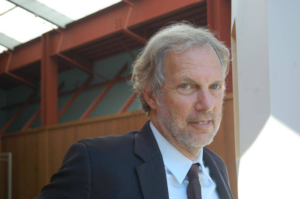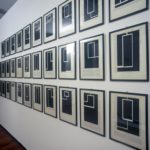Paul Simon en de Lage Landen
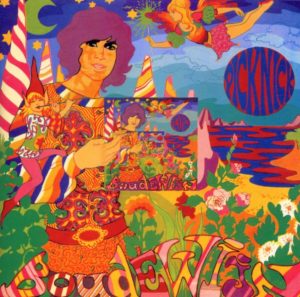 Het songwriters-duo Boudewijn de Groot-en-Lennaert Nijgh wordt wel beschouwd als de Nederlandse Lennon-and-McCartney. En niet geheel ten onrechte, want alleen al hun album Picknick (1967) is op een aantal punten te zien als de Nederpop-tegenhanger van Sgt. Pepper’s Lonely Hearts Club Band uit 1967: het nummer Picknick is, net als de eerste track van Sgt. Pepper, progammatisch voor het hele album, Mensen om me heen is qua thema het equivalent van With a little help from my friends, Cinderella is de Nederlandse Lucy in the sky with diamonds, de jaren dertig sound van When I’m sixty four keert terug in de Ballade voor de vriendinnen van één nacht, in de Ballade van wat beter is klinkt Getting better door en de orchestrale climax van A day in the life weerklinkt in het slotakkoord van Megaton. Om maar een paar voorbeelden te noemen.
Het songwriters-duo Boudewijn de Groot-en-Lennaert Nijgh wordt wel beschouwd als de Nederlandse Lennon-and-McCartney. En niet geheel ten onrechte, want alleen al hun album Picknick (1967) is op een aantal punten te zien als de Nederpop-tegenhanger van Sgt. Pepper’s Lonely Hearts Club Band uit 1967: het nummer Picknick is, net als de eerste track van Sgt. Pepper, progammatisch voor het hele album, Mensen om me heen is qua thema het equivalent van With a little help from my friends, Cinderella is de Nederlandse Lucy in the sky with diamonds, de jaren dertig sound van When I’m sixty four keert terug in de Ballade voor de vriendinnen van één nacht, in de Ballade van wat beter is klinkt Getting better door en de orchestrale climax van A day in the life weerklinkt in het slotakkoord van Megaton. Om maar een paar voorbeelden te noemen.
Het tweetal is ook de Nederlandse Bob Dylan genoemd, niet alleen omdat het een vertaling van The times they are a-changing opnam – Er komen andere tijden stond al op de lp Boudewijn de Groot (1965) -, maar ook, of vooral, omdat die titel hun motto werd, in ieder geval tijdens wat – overigens onder protest van Boudewijn de Groot – als hun protestsong- periode wordt gezien. Op Voor de overlevenden (1966), bijvoorbeeld, staat in Ze zijn niet meer als toen (de tekst is van Boudewijn zelf):
Er is gezegd: er komen andere tijden.
Er is gevochten voor een nieuw fatsoen.
Er is niet geluisterd naar wat anderen zeiden,
ik heb geen zin het nog eens over te doen.
Merkwaardig genoeg zijn Boudewijn de Groot en Lennaert Nijgh zelden vergeleken met Paul Simon, terwijl daar wel reden voor is. Al op hun eerste album stond Nijghs vertaling van The Sound of silence: Het geluid van de stilte. Overigens een abominabele vertaling van iemand die in diezelfde periode met Liefde van later een perfecte vertaling van Jacques Brels Chanson des vieux amants zou maken.
Toen Boudewijn de Groot, na de dood van zijn tekstleverancier in 2002, vaker zelf de pen ter hand nam, dook Paul Simon op in enkele van zijn teksten. Hij verzamelde en becommentarieerde die in de bundeling Hoogtevrees in Babylon. Alle eigen teksten van 1963 t/m 2006 (Baarn, 2007). Het nummer Hoogtevrees op het album Van een afstand (1980) ‘beschrijft een droom die zo duidelijk was en me ’s morgens nog zo helder en compleet voor de geest stond, dat de tekst er een letterlijke weergave van is. (..) Ik hoefde alleen maar uit bed te komen, te gaan zitten met pen en papier en de woorden kwamen vanzelf, compleet met rijm.’
In het eerste couplet dicht hij
Ik werd vergeleken met de groten der aarde,
ze zeiden ook dat het op Paul Simon leek.
Eerst was ik verrast toen begon het te hinderen,
maar niemand nam aanstoot,
hoe kwaad ik ook keek.
En in Hoogtevrees in Babylon op de cd Lage landen (2007) vinden we een terugverwijzing daarnaar in dit citaat
Paul Simon was degene
die vroeg waar ik mee bezig was
hij gaf me een paar stenen
en ging liggen in het gras
hij zei: wordt dit de hoogste toren
ooit door mensenhand gemaakt
dan weet je van tevoren
dat je wordt afgekraakt
hooggegrepen zinnen
theatrale melodie
het lijkt heel wat daarbinnen
maar blijkt een parodie
achttien trage kraaien
vlogen cirkels boven ons hoofd
je moet de leugen niet verdraaien
of je wordt niet meer geloofd
en
ik metselde mijn muren
duizend stenen in het rond
het kon niet lang meer duren
tot ik in de wolken stond
mijn moeder kon ik niet meer horen
Paul Simon schudde ‘t hoofd
ik dacht: je moet je niet laten storen
door wie niet in je gelooft
Chomsky: We Must Not Let Masters Of Capital Define The Post-COVID World
The global outbreak of COVID-19 has many thinking that a new economic and political order is inevitably under way. But is that so? In the U.S., the moneyed class, which has thrived under Donald Trump, won’t go down without pulling all stops to make sure that popular pressures for radical reforms will be blocked, says world-renowned public intellectual Noam Chomsky. Chomsky also reminds us that overt racism has intensified under Trump, and that police violence is a symptom of the underlying white supremacy that plagues U.S. society. Meanwhile, Trump’s anti-environmental policies and his trashing of arms control treaties are bringing the world ever closer to an environmental and nuclear holocaust.
C.J. Polychroniou: It’s been argued by many, from various quarters, that COVID-19 has been a game changer. Do you concur with this view, or are we talking of a temporary situation, with a return to the “business as usual” approach being the most likely scenario once this health crisis is over?
Noam Chomsky: There is no way to predict. Those who have primary responsibility for the multiple crises that imperil us today are hard at work, relentlessly, to ensure that the system they created, and from which they have greatly benefited, will endure — and in an even harsher form, with more intense surveillance and other means of coercion and control. Popular forces are mobilizing to counter these malign developments. They seek to dismantle the destructive policies that have led us to this uniquely perilous moment of human history, and to move toward a world system that gives priority to human rights and needs, not the prerogatives of concentrated capital.
We should take a few moments to clarify to ourselves the stakes in the bitter class war that is taking shape as the post-pandemic world is being forged. The stakes are immense. All are rooted in the suicidal logic of unregulated capitalism, and at a deeper level in its very nature, all becoming more apparent during the neoliberal plague of the past 40 years. The crises have been exacerbated by malignancies that have surfaced as these destructive tendencies took their course. The most ominous are appearing in the most powerful state in human history — not a good omen for a world in crisis.
The stakes were spelled out in the setting of the Doomsday Clock last January. Each year of Trump’s presidency, the minute hand has been moved closer to midnight. Two years ago, it reached the closest it has been since the Clock was first set after the atomic bombings. This past January, the analysts abandoned minutes altogether and moved to seconds: 100 seconds to midnight. They reiterated the prime concerns: nuclear war, environmental destruction and deterioration of democracy, the last of these because the only hope of dealing with the two existential crises is vibrant democracy in which an informed population is directly engaged in determining the fate of the world.
Since January, Trump has escalated each of these threats to survival. He has continued his project of dismantling the arms control regime that has provided some protection against nuclear disaster. So far this year, he has terminated the Open Skies Treaty, proposed by Eisenhower, and imposed frivolous conditions to block the re-negotiation of New Start, the last pillar of the system. He is now considering ending the moratorium on nuclear tests, “an invitation for other nuclear-armed countries to follow suit,” said Daryl Kimball, executive director of the Arms Control Association.
The military industry can scarcely control its euphoria over the flood of gifts from the public to develop new weapons to destroy us all, encouraging adversaries to do likewise so that down the road, new grants will flow to try to counter the new threats to survival. A hopeless task, as virtually every specialist knows, but that is not pertinent; what matters is that public largesse should flow into the right pockets.
Trump also has continued his dedicated campaign to destroy the environment that sustains human life. His FY 2020 budget proposal, issued while the pandemic was raging, called for further defunding of the Centers for Disease Control and Prevention and other health-related components for government, compensated by increased support for the fossil fuel industries that are destroying the prospects for survival. And, as usual, more funding for the military and for the [border] wall that is a central part of his electoral strategy. The corporate leaders Trump has installed to supervise environmental destruction are quietly eliminating regulations that somewhat constrain the damage and that protect the population from poisoning water supplies and the air they breathe. The latter reveals sharply the malevolence of the Trump phenomenon. In the midst of an unprecedented respiratory pandemic, Trump’s minions are seeking to increase air pollution, which makes COVID-19 more deadly, endangering tens of thousands of Americans. But it doesn’t much matter. Most have no choice but to live near the polluting plants — [those] who are poor and Black, and who vote the “wrong” way.
The Initiative For Fair Open Access Publishing In South Asian Studies ~ The 2020 Manifesto
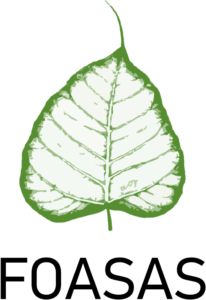 The 2020 Manifesto for Fair Open Access Publishing in South Asian Studies
The 2020 Manifesto for Fair Open Access Publishing in South Asian Studies
Profiteering and restricted access have led to a crisis in academic publishing. The Fair Open Access movement is best promoted by mobilizing individual disciplines. With this manifesto, we, an open group of scholars of classical and modern South Asian Studies, declare our support for Fair Open Access publishing.
§1 As is well known, the impact of publications is very often contingent on factors independent of the quality of the research or the competence of the authors. This includes that the research is published in a renowned journal (or other publication medium), by a renowned editor, or – and this has become a major problem – by a prestigious publishing house.
§2 Most of the prestigious publication media are nowadays controlled by a small number of profiteering international publishers. These companies often sell their products at unjustifiably high prices. Much of the editorial work, on the other hand, is outsourced to researchers (or their co-workers, assistants, employees, secretaries etc.). Because they depend on the prestige capitalized on by the publishers, they generally do this without payment. This situation has led to a real crisis in academic publishing.
§3 The Open Access (OA) movement is a reaction to this development: the advance of digitization has made it easy to make the results of research freely available on the internet. OA publishing offers free access to research, regardless of an individual’s financial means or affiliation with a subscribing institution. In the OA model, the individual reader does not pay (except, of course, in the case of printed works). Instead, the publication costs are borne by universities, libraries, scholarly societies, professional associations or other scholarly institutions. While in the wake of this development a number of institutions have founded in-house publishing projects, some commercial publishers have started to offer OA as well.
§4 In order to compensate for the revenue losses resulting from the free availability of OA publications, however, some profiteering publishers have begun to calculate special fees – imposed on the authors or their institutions. Most often, these fees are unjustifiably high and overcompensate for the production costs. As a growing number of academic institutions nowadays demand that the publications of their employees be OA, they are willing to pay these fees. They even regularly schedule a special budget to finance the publishers.
§5 Ultimately, however, it is the tax payers who have to pay, often several times: funding for research and researchers, library budgets for subscription fees, acquisition of overpriced books, processing costs charged by the publishers for OA publications etc. The only reason this system functions is that researchers and their institutions are dependent on the prestige that profiteering publishers have capitalized on for commercial benefit.
Go to (incl. List of Publishers & Journals): https://foasas.org
It’s Time To Nationalize The Fossil Fuel Industry
The COVID-19 pandemic’s impact on the economy provides a golden opportunity for creating a fairer, more just and sustainable world as it shatters long-held assumptions about the economic and political order. Its impact on the energy industry in particular can boost support for tackling the existential threat of global warming by raising the prospect of nationalizing and eventually dismantling fossil fuel producing companies, a position argued passionately by one of the world’s leading progressive economists, Robert Pollin, distinguished professor of economics and co-director of the Political Economy Research Institute at the University of Massachusetts at Amherst.
C.J. Polychroniou: It has been argued by many that the coronavirus pandemic is a game changer for numerous industries, and could change the way we work and the way we use energy. We could also see the possible return of the social state and thus the end of austerity. First of all, are there any comparisons to be made between the current health and economic crises and what took place during the Great Depression?
Robert Pollin: There is one big similarity between the economic collapse today and the 1930s Great Depression. That is the severity of the downturns in both cases. The official U.S. unemployment rate coming from the Labor Department as of May 2020 was 13.3 percent. But a more accurate measure of the collapsing job market is the number of workers who have applied for unemployment insurance since the lockdown began in mid-March. That figure is 44 million people, equal to about 27 percent of everyone in the current U.S. labor market, employed or unemployed. By contrast, during the Great Recession of 2007-09, official unemployment peaked, and for one month only, at 10.0 percent.
However, between 1930 and 1939, U.S. unemployment averaged about 18 percent, peaking at nearly 25 percent in 1933. The obvious difference between the 1930s and now is that the 1930s figure is an average over 10 brutal years. Our current severe job market is not going to last for 10 years. It could only last for a few more months, before the official unemployment rate gets to something like the more “benign” levels of Great Recession years, i.e. “only” 8-9 percent. Still, since the March lockdown, the severity of the unemployment crisis has been comparable to the 1930s.
This brings up the single most critical point of contrast between the 1930s and today. That is, we could have easily seen a decade-long economic depression now, except for the fact that the federal government today has intervened to an unprecedented extent to counteract the depression, while in the 1930s, the government did not intervene at the necessary scale until World War II.
The list of ways in which orthodox economists and government policymakers today are clueless is very long indeed. But they have at least figured out that, to stave off a 1930s-level depression, you pump massive amounts of money into the economy. For now, this has thus far included the so-called CARES Act, which passed Congress and Trump signed in March. This was a $2 trillion injection, equal to about 10 percent of the overall U.S. economy (Gross Domestic Product, or GDP), and still more important, Federal Reserve bailout funds for big corporations and Wall Street, to the tune of something like $5 trillion — 25 percent of GDP — and counting. Without the CARES Act and Federal Reserve bailouts, we could easily be looking right now at a replay of the 1930s. Things are bad enough as it is, of course. Plus, it is clear that the federal government funds are largely being stuffed into the pockets of corporations instead of where they are needed. Spending on public health — in the midst of a pandemic no less — as well as public education, and direct support for workers and the poor are getting short shrift, as usual.
The oil and gas industry has been particularly hard hit during the coronavirus pandemic. In that context, some, including yourself, have argued quite passionately that the time is ripe for nationalizing the fossil fuel industry. What would be the advantages of doing so? And how could we finance the transition to a sustainable energy future?
The underlying issue here is that, according to the thoroughly mainstream and highly cautious projection of the Intergovernmental Panel on Climate Change (IPCC) we, the residents of planet Earth, have 30 years total to achieve net zero carbon dioxide (CO2) emissions to have a reasonable chance of avoiding the most severe impacts of climate change — in terms of heat extremes, heavy precipitation, droughts, floods, sea-level rise and biodiversity, and the corresponding impacts on health, livelihoods, food security, water supply and human security. There is no avoiding what this means — which is that the global fossil fuel industry simply must be put out of business within the next 30 years. This is for the simple reason that burning fossil fuels to produce energy is what spews CO2 into the atmosphere, and is therefore the primary cause of climate change. The need to put an end to the fossil fuel industry remains an imperative, regardless of whether the industry is facing financial difficulties, as they are at present, or swimming in profits. Everyone on the planet simply has to stop burning oil, coal and natural gas to produce energy. We can, of course, take it as a given that the fossil fuel companies will fight fiercely, using every single tool at their disposal, to keep themselves alive, so that they can continue to reap big profits from destroying the Earth.
Nagekomen post
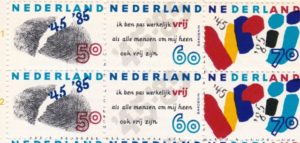 In 1984 vroeg de PTT kunstenaar Jan Bons een aantal postzegels te ontwerpen voor de veertigjarige herdenking van de Bevrijding in 1985. Voor zijn 60-cent zegel wilde hij een uitspraak van een van de aartsvaders van het anarchisme, Michael Bakoenin gebruiken: ‘Ik ben pas werkelijk vrij als alle mensen om mij heen ook vrij zijn’.
In 1984 vroeg de PTT kunstenaar Jan Bons een aantal postzegels te ontwerpen voor de veertigjarige herdenking van de Bevrijding in 1985. Voor zijn 60-cent zegel wilde hij een uitspraak van een van de aartsvaders van het anarchisme, Michael Bakoenin gebruiken: ‘Ik ben pas werkelijk vrij als alle mensen om mij heen ook vrij zijn’.
De PTT wees het ontwerp af. Anarchisten op postzegels, het is geen voor de hand liggende combinatie. De uitgifte van postzegels is immers van oudsher een staatsaangelegenheid en anarchisten zijn tegenstanders van iedere staatsvorm. Helemaal wereldvreemd is het verschijnsel toch niet.
Jan Bons had voor zijn ontwerp nog wel advies gevraagd aan historicus en Bakoenin-deskundige Arthur Lehning over de juistheid van de uitspraak. De beoordelingscommissie van de PTT had echter alleen maar negatief commentaar op de zegels van Bons, ook op het feit dat een uitspraak van een anarchist was gebruikt. Na veel geharrewar en nieuwe ontwerpen die opnieuw werden afgewezen, was Bons het zat en gaf hij de opdracht terug. Een velletje van de door Bons ontworpen zegels verscheen later als bijlage in een brochure over de affaire.
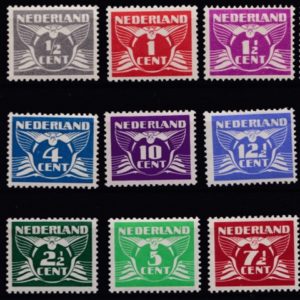 Vredesduif
Vredesduif
Op Nederlandse postzegels zijn geen anarchisten afgebeeld. Wel ontwierp kunstenaar Chris Lebeau (1878-1945), overtuigd anarchist, in de jaren dertig een telkens herdrukte reeks zegels die ook meerdere malen werd uitgebreid. Op een gekleurde ondergrond plaatste hij een witte vredesduif, met het aangezicht naar de kijker, op het buikje van de duif oplopende frankeringen: een halve cent, één cent, anderhalve cent, twee cent etc. Ook ontwierp hij nog enkele luchtpostzegels. Hij weigerde echter zegels met de koningin te ontwerpen. Lebeau ontwierp batikdoeken, tafelkleden, lampen, glas-in-loodramen, maar ook tapijten, glaswerk en affiches in art-decostijl. Tijdens de oorlog vervalste hij persoonsbewijzen. Hij stierf in het concentratiekamp Dachau. Wrang is dat tijdens de oorlog de bezetter, bij gebrek aan nieuwe postzegels, reeds gedrukte vellen van Lebeau’s zegels, overdrukte met een hakenkruis over de vredesduif. Deze zegels zijn echter nooit in omloop gebracht.
Partijleiders
De meest voorkomende figuur op postzegels is het staatshoofd, of deze nu gekozen is, of via erfopvolging, of dictatoriale weg op die plek terecht is gekomen. Op zegels van dictatoriaal geregeerde landen zijn veelal heroïsche gebeurtenissen uit de geschiedenis van het land afgebeeld. Zegels van het Libië onder Gadaffi en van het Korea van de familie Kim zijn daar sprekende voorbeelden van. Dit soort zegels zijn vooral een vorm van propaganda voor het regiem.
Ook in het vroegere communistische Oostblok was dat het geval, zoals in de DDR. Daar verschenen in de jaren vijftig en zestig veel zegels met Marx, Engels en Lenin en werden partijleiders Wilhelm Pieck en Walter Ulbricht vaak prominent geportretteerd. Onder de leiding van Erich Honecker verminderde echter het aantal zegels met Marx, Engels en Lenin.
Partijleiders verschenen ook steeds minder vaak op zegels. In die jaren verschoof het beeld naar bloemen, vogels en vlinders, industriële producten en telkens weer de Olympische Spelen, waar het land natuurlijk hoge ogen probeerde te gooien.
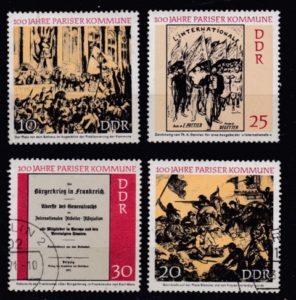 Volksopstand
Volksopstand
De DDR eigende zich op zegels historische personen en gebeurtenissen toe, hoewel die op zich geen verbintenis hadden met het land. Reeds overleden wetenschappers, kunstenaars, schrijvers en filosofen werden zonder probleem ingelijfd in de DDR-ideologie.
Communistische verzetsstrijders uit de nazitijd waren tijdens de Koude Oorlog een geliefd onderwerp op postzegels, bij voorkeur wanneer deze geboren waren of geleefd hadden op het toekomstige grondgebied van de DDR. Maar blijkbaar was dat niet altijd nodig want ook verzetstrijdster Hannie Schaft werd door de DDR op een zegel afgebeeld.
Zo kon de DDR ook honderd jaar na de spontane volksopstand van de Commune van Parijs (1871), deze met vier zegels moeiteloos in de communistische propaganda inlijven. Dat Karl Marx zich in enige bochten had moeten wringen om de opstand van de Commune in zijn ‘wetenschappelijke theorie’ van het communisme in te voeren, maakte het voor de DDR al een stuk makkelijker.
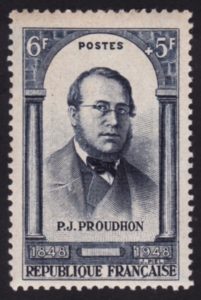 Franse Revolutie
Franse Revolutie
In Frankrijk zijn nooit postzegels verschenen met de Commune als onderwerp. Dit is een gevolg van de ambivalente houding die de Franse staat altijd inneemt ten opzichte van haar verleden. Aan de ene kant probeert zij haar glorieuze verleden – als staat – met prominente staatslieden en belangrijke momenten uit haar geschiedenis in stand te houden, aan de andere kant moet Frankrijk als voorvechtster van vrijheid, gelijkheid en broederschap hoog in het vaandel gehouden worden. Een lastige combinatie, zo illustreert de uitgifte van enkele zegels daar.
Aan de Franse Revolutie als gebeurtenis heeft de Franse staat nooit een zegel gewijd, al werden hoofdrolspelers Robespierre en Danton wel eens vereeuwigd. Frankrijk publiceerde zegels met staatslieden als Napoleon I en Napoleon III en veel historische monumenten als de Arc de Triomphe, het Élysée-paleis en het Louvre. Presidenten als Mitterrand, Pompidou en De Gaulle en enkele sociaal-democratische politici als Jean Jaures en Léon Blum zijn voor de eeuwigheid op zegels vastgelegd. Zo ook de conservatieve politicus Adolphe Thiers, de ‘slachter van de Commune’.
In de schemering van deze figuren staan sporadisch afgebeelde socialisten en anarchisten, echter niet in die hoedanigheid. Pierre-Joseph Proudhon (1809-1865), een der grondleggers van de anarchistische theorie, verscheen in 1948 op een zegel. Dit een serie ter herdenking van de revolutie van 1848, met onder anderen portretten van Louis Blanc, Louis-Auguste Blanqui en Armand Barbès. De rol van Proudhon tijdens die revolutie was overigens beperkt.
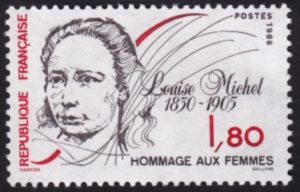 Commune van Parijs
Commune van Parijs
Weliswaar is de bekendste deelnemer aan de Parijse Commune, Louise Michel (1830-1905), de ‘Rode Maagd’, in Frankrijk op een postzegel afgebeeld, maar niet vanwege haar rol tijdens die opstand. Tijdens de Commune vocht ze op de barricades en verzorgde ze gewonde opstandelingen. Later was Michel actief als voorvechtster van vrouwenrechten en organiseerde ze onderwijs voor kinderen uit arme milieus. Het Franse eerbetoon aan haar is nogal beperkt, hoewel veel scholen naar haar vernoemd zijn. In Parijs is geen straat die haar naam draagt, al is er in de Parijse wijk Levallois Perret, niet ver van de begraafplaats waar haar graf te vinden is, een metrostation Louise Michel. Op een postzegel uit 1986 krijgt haar portret het predicaat ‘Hommage aux Femmes’ mee.
Voor een andere deelnemer aan de Commune geldt hetzelfde: Jules Vallès (1832-1885). Namens het 15e Arrondissement werd hij gekozen in de Raad van de Commune. De zegel die in 1982 verscheen met zijn beeltenis, herdenkt alleen zijn 150 e geboortedag en eert hem als schrijver en journalist, niet als betrokkene bij de Commune.
Protestsongs
Anders ging het in Zweden, waar de posterijen in 1980 de syndicalistische vakbondsstrijder, folkzanger en schrijver van tientallen protestsongs, Joe Hill (1879-1915) herdachten. De zegel heeft als toevoeging: ‘We’ll have freedom, love and health, When the grand red flag 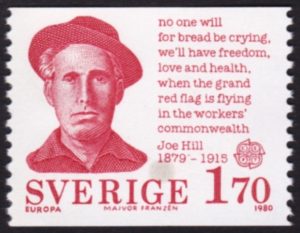 is flying, In the Workers’ Commonwealth.’ De oorspronkelijk in Zweden geboren Hill werd het boegbeeld van de vakbond Industrial Workers of the World (IWW). Met zijn venijnige songs, die opriepen tot een arbeidersrevolutie, was hij een doorn in het oog van mijnbazen en fabriekseigenaren. Toen hij na een roofoverval gearresteerd werd – waarvan nooit duidelijk is geworden of hij die pleegde – leek het een uitgelezen kans de populaire zanger de mond te snoeren. Na een dubieus proces werd hij in 1915 in Utah geëxecuteerd.
is flying, In the Workers’ Commonwealth.’ De oorspronkelijk in Zweden geboren Hill werd het boegbeeld van de vakbond Industrial Workers of the World (IWW). Met zijn venijnige songs, die opriepen tot een arbeidersrevolutie, was hij een doorn in het oog van mijnbazen en fabriekseigenaren. Toen hij na een roofoverval gearresteerd werd – waarvan nooit duidelijk is geworden of hij die pleegde – leek het een uitgelezen kans de populaire zanger de mond te snoeren. Na een dubieus proces werd hij in 1915 in Utah geëxecuteerd.
Verzamelaars
In zijn algemeenheid is de politieke overtuiging van anarchisten vrijwel nooit een reden om hun portret op een zegel te plaatsen, maar spelen andere redenen een rol om naam en persoon te vereeuwigen.
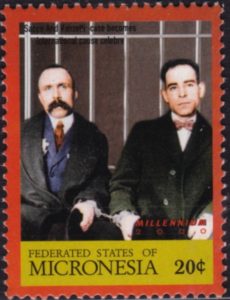 Mexico staat niet bekend als een gedecentraliseerde, optimaal democratische staat. Toch beweert de regering nog steeds te handelen vanuit het gedachtegoed van Emiliano Zapata, de anarchistische boerenleider die tijdens de Mexicaanse Revolutie (1910-1920) streed voor landhervormingen. Het uitbrengen van zegels met Zapata heeft dan ook slechts een propagandistische waarde.
Mexico staat niet bekend als een gedecentraliseerde, optimaal democratische staat. Toch beweert de regering nog steeds te handelen vanuit het gedachtegoed van Emiliano Zapata, de anarchistische boerenleider die tijdens de Mexicaanse Revolutie (1910-1920) streed voor landhervormingen. Het uitbrengen van zegels met Zapata heeft dan ook slechts een propagandistische waarde.
De reden waarom Micronesië, een eilandenstaat in de Stille Zuidzee, Sacco en Vanzetti – twee onschuldig in de Verenigde Staten in 1927 ter dood veroordeelde Italiaanse anarchisten – op een zegel plaatste, blijft echter nogal duister. Want zelfs voor verzamelaars is de waarde van dit soort zegels vrijwel nihil.
Van Bach tot Glass: Paul Simon en serieuze muziek
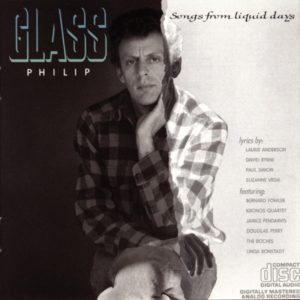 Op een aantal punten speelt klassieke muziek, althans serieuze muziek, een rol in het werk van Paul Simon. Veel Simon-fans zal het nummer American Tune op het album There goes Rhymin’ Simon (1973) bekend in de oren hebben geklonken. De echte kenners onder hen konden de melodie thuisbrengen als een deel uit de Mattheus Passie van Johan Sebastian Bach, en wel uit het choraal O, Haupt vol Blut und Wunden. Dat was op zich door Bach zelf weer geleend van Mein G’müt ist mir verwirret, een seculier, d.w.z. niet-kerkelijk, werk van Hans Leo Hassler von Roseneck (1564-1612).
Op een aantal punten speelt klassieke muziek, althans serieuze muziek, een rol in het werk van Paul Simon. Veel Simon-fans zal het nummer American Tune op het album There goes Rhymin’ Simon (1973) bekend in de oren hebben geklonken. De echte kenners onder hen konden de melodie thuisbrengen als een deel uit de Mattheus Passie van Johan Sebastian Bach, en wel uit het choraal O, Haupt vol Blut und Wunden. Dat was op zich door Bach zelf weer geleend van Mein G’müt ist mir verwirret, een seculier, d.w.z. niet-kerkelijk, werk van Hans Leo Hassler von Roseneck (1564-1612).
Over Bach als inspiratiebron heeft Simon zich, voor zover mij bekend, nooit uitgelaten.
In 1971 leverde Simon een tekst voor een compositie van Leonard Bernstein, vooral bekend van the West Side Story. Mass. A Theatre Piece for Singers, Players and Dancers is wat wij in revolutionairder tijden een beatmis noemden. Een opmerkelijk werk, deze katholieke mis door deze joodse componist.
Simons volledige bijdrage bestaat uit vier regels:
Half of the people are stoned
And the other half are waiting for the next election.
Half the people are drowned
And the other half are swimming in the wrong direction.
Bernstein bedankt hem met deze voetnoot:
This quatrain was a Christmas present from Paul Simon. Gratias. L.B.
(Dit kwatrijn was een Kerstgeschenk van Paul Simon. Merci. L.B.)
Changing opinion
Gradually we became aware of a hum in the room
An electrical hum in the room
It went mmmmmm
We followed it from corner to corner
We pressed out ears against the walls
We crossed diagonals and put our hands on the floor
It went mmmmmm
Sometimes it was a murmur
Sometimes it was a pulse
Sometimes it seemed to disappear
But then with a quarter-turn of the head
It would roll around the sofa
A nimbus humming cloud
Mmmmmm
Maybe it’s the hum of a calm refrigerator
Cooling on a big night
Maybe it’s the hum of our parents’ voices
Long ago in a soft light
Mmmmmm
Maybe it’s the hum of changing opinion
Or a foreign language in prayer
Maybe it’s the mantra of the walls and wiring
Deep breathing in soft air
Mmmmmm
Paul Simon, toch al niet bekend om de toegankelijkheid van zijn teksten, bereikte hiermee een nieuw hoogtepunt in diepgang.
De gezamenlijk inspanningen mondden uit in de cd Songs from Liquid Days (1986), zo genoemd naar de bijdrage van David Byrne. Glass had in 1983 al meegewerkt aan het Paul Simon album Hearts and bones. Hij schreef de coda (het afsluitend deel van een muziekstuk) waarmee de plaat eindigt.
Dat was overigens nog niet het einde van hun collaboratie. Op 23 mei 2007 werd aan Paul Simon de eerste Gershwin Prize for Popular Song uitgereikt. Tot de gastoptredens – van James Taylor en Miriam Makeba tot Art Garfunkel en Stevie Wonder – hoorde ook dat van Glass, die een solopiano versie van Sound of silence speelde.
En aan het booklet bij de 3cd-box Paul Simon 1964 – 1993 droeg Glass het essay Graceland and beyond bij. Daarin plaatst hij Simon, wellicht tot diens eigen verbazing, op één lijn met de belangrijkste Amerikaanse deuntjesmakers:
“For me, Paul Simon is, simply, one of the leading songwriters of modern times, responsible for more ‘standards’ than any other single songwriter of his generation. You have to go back to composers like Porter, Gershwin and Berlin to find comparable talent.”
(Voor mij is Paul Simon eenvoudigweg een van de meest vooraanstaande songwriters van de moderne tijd, verantwoordelijk voor meer ‘standards’ dan enige andere tekstschrijver-en-componist van zijn generatie. Je moet teruggaan tot componisten als Porter, Gershwin en Berlin om vergelijkbaar talent te vinden.)
Op de een of andere manier doet een vergelijking met Cole Porters Night and day, George Gershwins I got rhythm en Irving Berlins White Christmas, om maar een paar ‘standards’ te noemen, met Bridge over troubled water, The boxer en Duncan me sterk denken aan appels en peren.
—
Robert-Henk Zuidinga (1949) studeerde Nederlandse en Engelse Moderne Letterkunde aan de Universiteit van Amsterdam. Hij schrijft over literatuur, taal- en bij uitzondering – over film.
De drie delen Dit staat er bevatten de, volgens zijn eigen omschrijving, journalistieke nalatenschap van Zuidinga. De boeken zijn in eigen beheer uitgegeven. Belangstelling? Stuur een berichtje naar: info@rozenbergquarterly.com– wij sturen uw bericht door naar de auteur.
Dit staat er 1. Columns over taal en literatuur. Haarlem 2016. ISBN 9789492563040
Dit staat er II, Artikelen en interviews over literatuur. Haarlem 2017. ISBN 9789492563248
Dit staat er III. Bijnamen en Nederlied. Buitenlied en film, Haarlem 2019. ISBN 97894925636637

